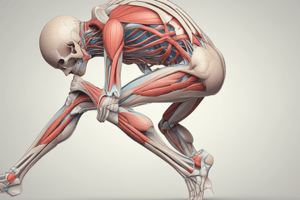Podcast
Questions and Answers
Which nerve is responsible for carrying the stimuli back to the quadriceps muscle during the knee jerk reflex test?
Which nerve is responsible for carrying the stimuli back to the quadriceps muscle during the knee jerk reflex test?
- Tibial nerve
- Obturator nerve
- Femoral nerve (correct)
- Sciatic nerve
What is the purpose of the inhibitory stimuli released by local interneurons during the knee jerk reflex test?
What is the purpose of the inhibitory stimuli released by local interneurons during the knee jerk reflex test?
- To initiate an action potential in the muscle spindle
- To stimulate the quadriceps muscle
- To facilitate the relaxation of the opposing muscle
- To block the stimulation of the hamstring muscles (correct)
What may be the cause of the absence of the patellar tendon reflex during the knee jerk reflex test?
What may be the cause of the absence of the patellar tendon reflex during the knee jerk reflex test?
- Lesion that interrupts the innervation of the tibial nerve
- Lesion that interrupts the innervation of the quadriceps (correct)
- Lesion that interrupts the innervation of the sciatic nerve
- Lesion that interrupts the innervation of the hamstring muscles
Flashcards are hidden until you start studying
Study Notes
- Knee jerk reflex (patellar reflex) is a test of the integrity of the femoral nerve and the L2-L4 spinal cord segments.
- When the patella is struck below the knee by a reflex hammer, it initiates an action potential in a specialized structure called a muscle spindle located within the quadriceps.
- This action potential travels to the L2, L3, and L4 nerve roots of the spinal cord via a sensory axon (femoral nerve) which chemically communicates with the motor nerve.
- The motor nerve (femoral nerve) carries stimuli back to the quadriceps muscle that make this muscle contract, leading to extension of the lower leg at the knee.
- The sensory input from the quadriceps also activates local interneurons that release inhibitory stimuli onto motor neurons of antagonist muscles, blocking their stimulation (in this case, the hamstring muscles).
- The relaxation of the opposing muscle facilitates (by not opposing) the extension of the lower leg.
- The reflex is routinely tested during a physical examination by having the person sit with the legs dangling.
- A firm strike on the ligament with a reflex hammer usually causes the leg to extend.
- Diminution or absence of the patellar tendon reflex may result from any lesion that interrupts the innervation of the quadriceps (e.g. peripheral nerve disease).
- Clinical correlation I is related to the knee jerk reflex (patellar reflex).
Studying That Suits You
Use AI to generate personalized quizzes and flashcards to suit your learning preferences.




